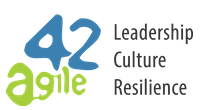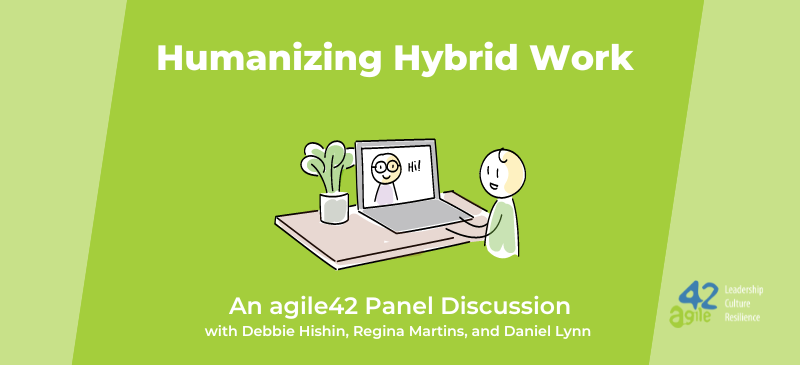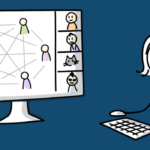Panel Discussion | Humanizing Hybrid Work
In the wake of the Covid-19 pandemic, trends like “The Great Resignation” have kicked off a long overdue conversation about hybrid and remote work, and how to do this well. For example, some hybrid workers complain that they go to the office to log on to Zoom or Teams only to spend the rest of the day with their headphones on because the rest of their team is at home. A lot of people feel disconnected from their teams and that they are missing out on the human element of work. agile42’s coaches recently discussed this in the Humanizing Hybrid Work webinar.
Watch now | Humanizing Hybrid Work
At agile42, we’ve worked in hybrid and remote setups for over 15 years, and we specialize in helping to build more effective and resilient teams. In this panel discussion, our Agile coaches, Regina Martins, Debbie Hishin, and Daniel Lynn offer a different perspective by focusing on the human element of hybrid work and by using the four Agile values as an anchor point for this discussion. Watch as they unpack the complexities of this conversation, delving into the pros and cons of various working arrangements, and share the innovative solutions they’ve come up with to make things go more smoothly.
Stay in the loop about upcoming webinars by joining our mailing list
Five key takeaways from the webinar
1. Make use of goal setting and team agreements
According to coach and director of agile42 South Africa, Regina Martins, goal-setting has helped her and her teammates communicate effectively. In fact, goal setting can be used for organizational change. They are very explicit about their goals and co-created them to make sure that everyone is aligned and working towards the same things. Being face-to-face is not a prerequisite for being more effective. Virtual interactions and the value obtained from these interactions can be as effective as those that take place in person if you’re aligned on agreements and goals.
2. Be intentional about hybrid working
We discovered through this discussion that people have many different definitions of hybrid work. For some people, it means going to the office some days, and for others, it means that some people are together while others are at home. While there are varying instances and definitions of hybrid work, our coaches agreed that we should be intentional about it. Collaboration that requires lots of creativity and constructive conflict benefits from being in one room. So, things like design, strategy, and goal-setting could be good opportunities for people to meet in person. Another option is to hold your Scrum events (excluding the Daily Scrum) in person. Make sure that your in-person days are centered around building connections rather than going about your day-to-day tasks.
3. Human connection is key
What a lot of people seem to lack in hybrid setups is human interaction and connection. There are many ways to overcome this, such as team-building activities or using tools that encourage collaborations, such as a virtual whiteboard or Miro. Agile coach, Debbie Hishin, also shared that a camera-on policy is a good idea to make sure we are picking up on non-verbal communication. Some other ideas could be to use a team notice board or a kudos channel. As a leader, make some time to check in with colleagues and see how they are feeling.
Just because there is no office doesn’t mean there can’t be any office banter. Get creative with ways to connect. Debbie Hishin suggests trying a GIF Friday where you can only reply with GIFs!

Photo by Andrea Piacquadio on Pexels
Lastly, when you do meet in-person, make sure these sessions are geared towards human connection. So that we can build trust and make sure relationships are intact for when we work remotely.
4. Always come back to your why – understanding people’s needs
Many companies are asking employees to return to the office which has been met with mixed responses. If you are unsure about new policies or what will work in the long term, it always comes back to your “why”. Ultimately it should be about meeting the needs of our employees. Are these needs being met in the office or at home? Just like companies need to think about why clients would buy something, they should also think about why their employees would buy into working from home or at the office. What are the selling points for people, and then try to work around that.
Leaders in remote and dispersed environments need to understand these needs and make sure they are creating a safe environment for people to perform their best. This is where Agile leadership can make a meaningful impact.
Recommended online course: Agile Leadership Foundations
5. Know your boundaries
US-based coach, Daniel Lynn, shares that empathy is very important in remote settings, and this means understanding people’s boundaries. Zoom fatigue is a very real thing, so make sure you are regularly taking breaks. Often, to make up for the lack of face-to-face connection, people get bombarded with meetings. In this case, it’s important that people feel empowered to say no and have boundaries.
It’s also the case that not everyone wants to participate in work events after hours, and that’s okay too. Just because we are working in hybrid settings doesn’t mean we should over-commit or feel that we have to prove anything.
Browse the agile42Agile Certifications
agile42 offers Scrum courses, as well as:
- online Agile certifications;
- Kanban training with certification from Kanban University;
- ICAgile Agile Team Facilitation (ICP-ATF) and Agile Coaching Certification (ICP-ACC) training; and
- Scrum Alliance Certified Agile Leadership training.





